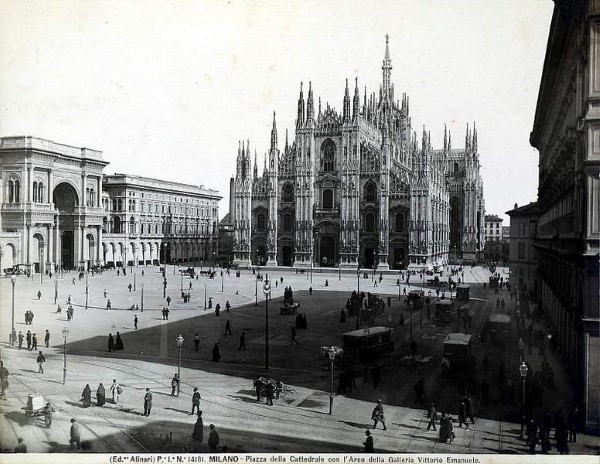- Also Mailand, Milano.
- Year 1890.
The political unification of Italy cemented Milan’s commercial dominance over northern Italy. It also led to a flurry of railway construction that had started under Austrian partronage (Venice–Milan; Milan–Monza) that made Milan the rail hub of northern Italy. Thereafter with the opening of the Gotthard (1881) and Simplon (1906) railway tunnels, Milan became the major South European rail focus for business and passenger movements e.g. the Simplon Orient Express.
Rapid industrialization and market expansion put Milan at the centre of Italy’s leading industrial region, including extensive stone quarries that have led to much of the air pollution we see today in the region. In the 1890s Milan was shaken by the Bava-Beccaris massacre, a riot related to a high inflation rate. Meanwhile, as Milanese banks dominated Italy’s financial sphere, the city became the country’s leading financial centre.
The tumultuous period of early 20th century brought several, radical innovations in Milanese architecture. Art Nouveau, also known as Liberty in Italy, is recognisable in Palazzo Castiglioni, built by architect Giuseppe Sommaruga between 1901 and 1904.
Other remarkable examples include Hotel Corso and Berri-Meregalli house, the latter built in a traditional Milanese Art Nouveau style combined with elements of neo-Romanesque and Gothic revival architecture, regarded as one of the last such types of architecture in the city. A new, more eclectic form of architecture can be seen in buildings such as Castello Cova, built the 1910s in a distinctly neo-medieval style, evoking the architectural trends of the past.
The music of Milan has ancient roots. The Ambrosian chants are among the first codified music in Western culture, which fact led to the later development of our concept of scales, for example. In more recent history, the city of Milan has been an important social, cultural, political and commercial center not just in Italy, but in all of Europe.
Milan is a major national and international centre of the performing arts, most notably opera. The city hosts La Scala operahouse, considered one of the world’s most prestigious, having throughout history witnessed the premieres of numerous operas, such as Nabucco by Giuseppe Verdi in 1842, La Gioconda by Amilcare Ponchielli, Madama Butterfly by Giacomo Puccini in 1904, Turandot by Giacomo Puccini in 1926, and more recently Teneke, by Fabio Vacchi in 2007. Other major theatres in Milan include the Teatro degli Arcimboldi, Teatro Dal Verme, Teatro Lirico and formerly the Teatro Regio Ducal.
The city is also the seat of a renowned symphony orchestra and musical conservatory, and has been, throughout history, a major centre for musical composition: numerous famous composers and musicians such as Gioseppe Caimo, Simon Boyleau, Hoste da Reggio, Verdi, Giulio Gatti-Casazza, Paolo Cherici and Alice Edun lived and worked in Milan.
- Giuseppe Verdi died in Milan (Year 1901).

